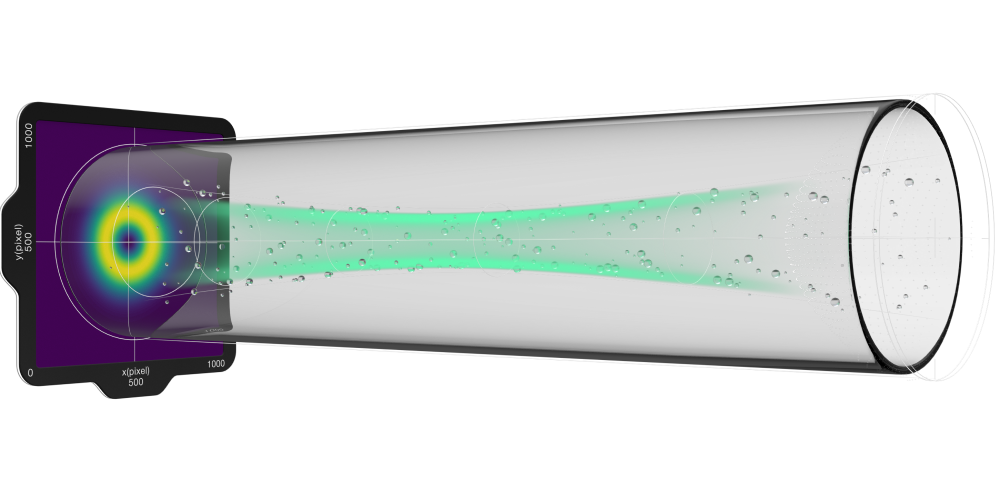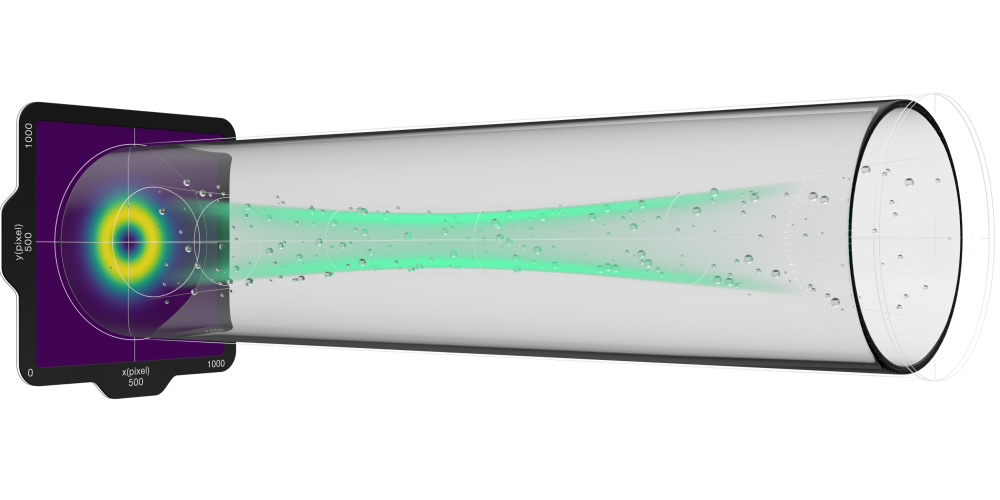Optical Vortex Sizes Up Nanoparticles
Nanoparticles are present in everything from paints to pharmaceutical products. While nanoparticles have many important characteristics, such as molecular composition and shape, it is their size that determines many chemical and physical properties. A new technique relying on an optical vortex—a laser beam whose wave fronts twist around a dark central region—allows researchers to characterize nanoparticle size rapidly and continuously [1]. This light-based size probe might one day find applications in numerous industrial settings and aid fundamental materials science research.
It is difficult to precisely synthesize nanoparticles with the desired dimensions, so manufacturers must often validate that their nanoparticles have the right size to comply with regulations and to ensure product quality. There are many ways of determining nanoparticle size, but one popular approach, dynamic light scattering (DLS), is based on measurements of Brownian motion, the random particle movement caused by jostling from the surrounding liquid medium. In DLS, the Brownian motion is determined by measuring fluctuations in laser light scattering from the nanoparticles. In general, the faster the Brownian motion, the smaller the particles. But current techniques are generally not capable of characterizing the largest particles and measuring them continuously.
Dubbed optofluidic force induction (OF2i), the new method uses light—in the form of an optical vortex—to both track the motion and provide a force. For nanoparticles with a diameter larger than 200 nm, OF2i infers size from the velocity the particles gain from the optical force. “We know how much faster they go because of the laser light,” says Christian Hill, a biophysicist at the Medical University of Graz in Austria and founder of BRAVE Analytics, which is selling a prototype device that performs OF2i.
In OF2i, nanoparticles in a water solution flow horizontally through a small channel. The optical vortex is directed down the channel, exerting a force on the nanoparticles that both pushes them forward and turns them around the beam’s center (the turning comes from the vortex’s angular momentum; see Focus: Giving Light a New Twist). In response, the nanoparticles follow a spiral trajectory, which minimizes interparticle collisions that would disrupt the measurements. The laser light also scatters off the nanoparticles, illuminating them so that they can be seen by a microscope located beneath the channel. Hill and his colleagues link together snapshots of the particles to form a “waterfall plot” that illustrates the particle trajectories.
The shape of a nanoparticle trajectory provides information on how the particle’s velocity is changing and thus how much optical force it experiences. Bigger nanoparticles receive a stronger push from the light—similar to sailboats with larger sails getting a bigger boost from the wind. OF2i essentially works by calculating the sail size from the speed of the boat.
As a proof of concept, the researchers showed that their novel optical-force approach can measure polystyrene particles with diameters between 200 and 900 nm. The high-end of this range goes beyond the capabilities of previous Brownian-based techniques, as micrometer-sized particles do not exhibit Brownian motion. However, for particles smaller than 200 nm, the velocity change due to optical forces is too small to measure, so Hill and his colleagues have to resort to measuring size via scattering fluctuations, similar to DLS.
Besides measuring a large range of particle sizes, OF2i also has the advantage of providing real-time data during nanoparticle synthesis, explains Marko Šimić, a team member from the Medical University of Graz and BRAVE Analytics. “[Nanoparticle producers] would like to know, for example, how changing some parameters influences the end product,” he says.
The team also hopes to extract additional information from nanoparticles using the technique. For example, oblong particles subjected to an optical force will rotate, which could allow the researchers to determine particle sphericity or even shape. Additionally, the scattered light should contain spectroscopic information about the elemental composition of nanoparticles. If the researchers could unlock these capabilities, they could have an all-purpose nanoparticle characterization technique.
Although OF2i shows promise, other experts in the industry say that they would like to see more data. “It might be a very elegant, very workable, and valuable method,” says Ad Gerich, the managing director of InProcess-LSP, an industry competitor in nanoparticle characterization. But he is unsure if it can actually do the job, as there were “too many gaps in the proof.” In particular, he would like to see tests with materials other than polystyrene to verify that OF2i works for nanoparticles whose response to the optical force is less well-known. The authors say that they plan to use other materials in future experiments.
–Dan Garisto
Dan Garisto is a science journalist based in New York City.
References
- M. Šimić et al., “Real-time nanoparticle characterization through optofluidic force induction,” Phys. Rev. Applied 18, 024056 (2022).
More Information
A video from BRAVE Analytics explaining the basic features of OF2i.






